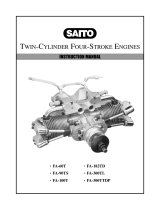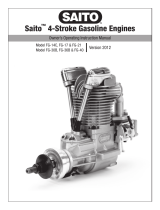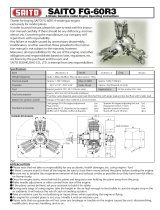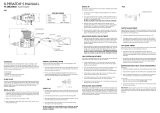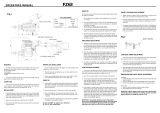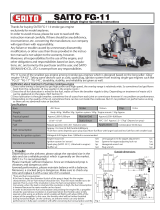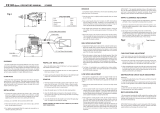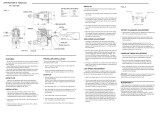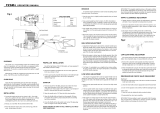Page is loading ...

INSTRUCTION MANUAL
•FA-170R3-D
•FA-325R5-D
•FA-450R3-D
Multi-Cylinder Four-Stroke Engines
Saito manual doc 11/12/01 2:10 PM Page a1

VERY
IMPORTANT:
Failure to read and
follow these instruc-
tions before you
proceed may result
in engine damage
and the voiding of
your warranty
Saito manual doc 11/12/01 2:10 PM Page a2

INTRODUCTION
Congratulations on your purchase
of a Saito 4-cycle engine. When
cared for properly, these high-
quality, finely crafted engines
offer many years of modeling
enjoyment.
This instruction manual has been
developed to ensure optimum per-
formance from the Saito engine
you’ve purchased. The instruc-
tions must be read thoroughly
prior to mounting and running the
engine.
SAFETY INSTRUCTIONS
This model engine will give you
considerable pleasure, satisfaction
and performance if you strictly
follow these safety instructions
and take heed of the warnings as
to its safe and proper use.
Remember at all times, THIS
ENGINE IS NOT A TOY, but
rather a precision-built machine
with more than enough power to
cause harm if misused or if the
safety precautions are not
observed.
YOU SHOULD ALWAYS:
1. When running the engine, be
sure that all spectators, especially
children, are at least 20 feet away.
2. Use the correct size and pitch
of propeller for your engine; refer
to the propeller chart in this man-
ual.
3. It is extremely important to bal-
ance the propeller prior to instal-
lation of the engine. Failure to do
so may cause damage to the Saito
engine and/or the airframe. Install
the propeller with the convex
(curved) side facing forward.
Securely tighten the propeller nut
against the washer and propeller.
A ”jam” nut (or anti-loosening
nut) is suggested for all 4-cycle
engines.
4. Keep your face and body away
from the path of the propeller
blades when starting or running
your engine.
5. Never allow your hands to
come close to the propeller.
Utilize either a “chicken stick”
or electric starter to start the
engine.
6. Make all carburetor adjust-
ments from behind the propeller.
7. To stop the engine, cut offfuel
supply (pinchor disconnect the
fuelline to the carburetor),or use
thethrottlelinkageto shut off the
air.
1
INTRODUCTION
Saito manual doc 11/12/01 2:10 PM Page 1

DO NOT USE HANDS, FINGERS
OR ANY OTHER PART OF THE
BODY TO STOP THE
PROPELLER.
DO NOT THROW ANY OBJECT
INTO A PROPELLER TO STOP
IT!
8. Discard any propeller that is
nicked, scratched, cracked or
damaged in any way.
I
T IS HIGHLY RECOMMENDED THAT:
1. Safety glasses or goggles be
used when starting and running
your engine.
2. You do not run the engine in
the vicinity of loose gravel or
sand. The propeller may throw
such materials into your eyes. The
engine may also ingest these
harmful materials.
3. Loose clothing should be
avoided when operating your
model engine. Loose clothing can
become entangled in the propeller,
creating the possibility of bodily
harm. Also, all loose objects
(screwdrivers, pencils, nickel cad-
mium starters, etc.) should be
removed from your pockets so
they do not fall into the propeller.
4. Glow plug clips and cords are
kept away from the propeller.
5. Your glow fuel is kept in a safe
place well away from sparks, heat
or anything that may ignite the
fuel.
BEWARE:
1. Model engines get very hot
while running. Do not attempt to
handle the engine until it has
cooled.
2. Always run your model engines
in a well-ventilated area. Similar
to automotive engines, model
engines produce possibly harmful
carbon monoxide fumes.
3. Remember that model engines
produce a substantial amount of
power, more than enough to seri-
ously injure people and/or do con-
siderable damage to property.
Always use common sense, skill
and constant observation of safety
precautions.
2INTRODUCTION
Saito manual doc 11/12/01 2:10 PM Page 2

DISASSEMBLY
The Saito multi-cylinder engines
are assembled using special jigs
and tools. As such, disassembly
should be performed only at the
factory authorized service center.
If it becomes necessary to dis-
mantle the engine, such as after
a crash, please send your engine
to the authorized service center:
Horizon Service Center
Attention: Saito Service
4105 Fieldstone Road
Champaign, IL 61822
(217) 355-9511
Disassembly of the engine will
result in the voiding of your war-
ranty.
ENGINE PARTS
IDENTIFICATION
It’s important to be able to identi-
fy the parts of your Saito engines.
In this manual you’ll find an
exploded view of Saito
multi-cylinder engines, as well as
a chart which includes part
numbers and descriptions. This
will assist you in easily and rapid-
ly identifying the respective parts
of your Saito engine.
SUPPORT EQUIPMENT
The following items, which are
not included with your Saito
engine, are necessary in order to
operate the model engine:
•Fuel — For maximum protec-
tion and longevity of Saito
engines, Saito manufacturing rec-
ommends good quality airplane
fuel with 10-15% nitro methane.
Such as, Morgan Fuels, Omega,
Cool Power, K&B, Power Master,
etc. Use of fuels composed entire-
ly of castor oil is NOT recom-
mended. A mix of synthetic-cas-
tor oil is acceptable and can be
found in the various fuel blends
described above.
•Propeller — Refer to the
Propeller Selection Chart, located
on page 15, to determine the best
initial propeller for your particular
application.
•Igniting Glow Plugs — Your
glow plugs may be properly heat-
ed by several different sources.
The FA-170R3D, FA-325R5D,
and FA-450R3D all have a
wiring harness kit that can be
used to provide several options
for providing heat to the glow
plugs. The red connectors are the
3
ENGINE PARTS IDENTIFICATION
Saito manual doc 11/12/01 2:10 PM Page 3

glow plug connectors and there’s
one black ground wire lead.
The red glow plug leads should be
connected to one another via a
common lead. Attach the glow
plug connectors to the rear glow
plugs.
NOTE: The connectors should
firmly grip the glow plug stems.
If not, gently squeeze the clip
together with your fingers.
NOTE: It is not necessary to
ignite all six of the glow plugs for
the FA-170/450 or all 10 of the
glow plugs for the FA-325. The
front plugs will ignite once the
engine reaches operating tempera-
ture. Attach the black (ground)
lead to the motor mount.
1. On-Board Battery.
a. Solder the single common
lead from the glow plug connector
to the terminal of a 125V 10A
micro-switch (not supplied).
b. Solder a lead from the micro-
switch to the positive terminal on
the Ni-Cad battery.
c. Attach the single lead from
the ground wire to the negative
terminal on the Ni-Cad battery.
Please refer to Fig. 1
d. The on-board battery system
may be activated in two ways.
First, using a servo to activate the
switch, insert the servo lead into
the gear (or other toggle-activated
switch) channel in the receiver.
Adjust the travel of the selected
channel so that the servo arm
”trips” the micro-switch and
completes the circuit, heating the
glow plugs accordingly. Placing
the toggle switch in the opposite
position will break the circuit,
removing the heat from the glow
plugs.
Alternatively, the servo may be
connected to the throttle channel
of the receiver via a Y-harness.
Adjust the servo travel so that
contact with the micro-switch is
completed at the desired location
generally a low idle position.
4SUPPORT EQUIPMENT
Saito manual doc 11/12/01 2:10 PM Page 4

2. Common Plug Activated
a. Solder the single lead from
the glow plug connectors to
one post of the female jack.
b. Attach the ground lead to the
remaining post on the female
jack.
To Glow Plug Connectors
c. Attach a male connector to
the positive and negative ter-
minals of your 1.5V starting
battery.
Refer to Fig. 2
3. Multi-Cylinder Glow Driver
There are many fine glow driver
units available on the market
today. Please follow the instruc-
tions included with the glow dri-
ver you’ve selected.
NOTE: The use of an on-board
glow system is highly recom-
mended. This will guarantee a
smooth, reliable idle. If an
on-board glow system will NOT
be utilized, replacement of the
standard McCoy glow plugs with
a ”hotter” plug, such as the
McCoy #3 heli plug (HAN3020),
K&B 4 cycle plug or equivalent is
suggested.
•Glow Plug Wrench — Used to
remove and tighten glow plugs.
•Manual or Electric Starter —
For manual starts, a ”chicken
stick” is highly recommended.
NEVER use your fingers to start
any model engine as doing so
invites injury. There are a variety
of electric starters on the market.
The Hangar 9 12V heavy-duty
Super Starter (HAN110) works
perfectly on all Saito multi-cylin-
der engines.
5
SUPPORT EQUIPMENT
Saito manual doc 11/12/01 2:11 PM Page 5

BREAK-IN
The first run on any engine,
whether 2-cycle or 4-cycle, is crit-
ical to the future of the engine
itself. During this time, metal
mating parts (piston and cylinder,
ball bearings, etc.) wear in. Care
must be taken that the engine is
clean and free of any dust or grit
that may have accumulated while
building the model.
There are two accepted methods
for breaking in a new engine:
either running it mounted on a test
stand or in an aircraft. Either
method is acceptable; however,
mounting the engine to a test
stand allows the engine to be
observed throughout its operation,
as well as elevating it above the
ground and away from harmful
dust and dirt.
NOTE: Because your engine may
have been sitting for an extended
period of time prior to running it,
a few drops of light oil applied
through the crankcase breather
nipple (19 on the exploded view),
if applicable, and down the
pushrod tubes (40) will ensure
proper lubrication for the first run.
Regardless of the mountingmet-
hod chosen for break-in,the
following proceduresareapplicable:
1. Use a break-in fuel as
described in the ”Support
Equipment” section, of
this manual.
2. Use the proper glow plugs.
Your engine includes the Hangar
9/McCoy MC-4C (HAN3010)
glow plugs, which are standard
replacement glow plugs for
these engines.
3. Select the correct propeller. To
do so, refer to the Propeller
Selection Chart on page 15 of this
manual.
4. Ensure that the high-speed nee-
dle valve (85) is opened (turned
counterclockwise) five full turns.
This guarantees a very rich set-
ting.
DO NOT adjust the low-speed
needle valve at this time. The low
speed needle valve is pre-adjusted
at the factory for initial break-in.
5. The use of a tachometer is
highly recommended since the
adjustment of a 4-cycle engine,
while similar to that of a 2-cycle
engine, is more difficult to
“set by ear,” making it easier to
damage the engine by ”over lean-
ing.”
6BREAK-IN
Saito manual doc 11/12/01 2:11 PM Page 6

STARTING THE ENGINE
1. Make sure the glow plugs are
installed and tightened.
2. Be sure the propeller is proper-
ly secured. The use of a ”jam nut”
is encouraged on 4-cycle engines.
3. Make sure the fuel tank line(s)
are properly connected. The main
line should be connected to the
carburetor spray bar (84). The
proper ”plumbing” of the lines is
extremely important to the perfor-
mance of any engine.
4. Be certain the mufflers are
installed properly by oiling the
threads and inserting the crush
washers, and that the lines are
properly connected.
5. Fill the fuel tank.
6. Check to make sure the glow
plugs are not connected to the
heat source (glow plug clip/lock-
ing socket).
Note: If an electric starter will be
used to start the engine, it’s not
necessary to prime the engine. To
do so may result in an engine
which becomes hydro-locked and
serious damage can occur.
7. Open throttle fully.
8. Close the choke valve (92), if
applicable (FA-450).
NOTE: The FA-170R3D and the
FA-325R5D require priming via a
syringe.
9. Turn the prop one or two turns
clockwise to suck in the fuel (FA
450 only).
10. Open the choke valve (92), if
applicable (FA-450).
7
STARTING THE ENGINE
Saito manual doc 11/12/01 2:11 PM Page 7

NOTE: The priming process for
the FA-170R3D is described as
follows:
For priming, inject the approxi-
mate quantity of fuel (about 1-2
cc) into the carburetor with a
syringe, etc. as illustrated.
NOTE: the priming process for
the FA-325R5D is described as
follows:
For priming, inject the approxi-
mate quantity of fuel (about 1-2
cc) into the injection pipe on the
rear of the engine as illustrated.
After priming, be sure to install
the plug.
START THE ENGINE:
11. Close the throttle to 1/4 to 1/3
open position.
12. Rotate the propeller clockwise
until it’s against the compression
stroke.
13. Rotate the propeller in a coun-
terclockwise direction 2-3 times
(FA-170/FA-325). If much force
is needed to turn the propeller, the
fuel in cylinders 2 and 3 (for an
FA-170/450; 2 and 5 for an FA-
325) is compressed. Remove the
glow plugs from these cylinders
and slowly rotate the propeller
clockwise to eject the excess fuel
via the cylinder heads.
14. Connect the heating source to
the glow plugs.
8STARTING THE ENGINE
Saito manual doc 11/12/01 2:11 PM Page 8

NOTE: It’s not necessary to ignite
all the plugs in a dual plug cylin-
der (two glow plugs per cylinder)
of Saito engines. It’s only neces-
sary to apply heat to the rear
plugs; the front plugs will ignite
once the engine reaches operating
temperature.
NOTE: A very common error is to
remove the glow plug igniter (or
on-board glow driver) too early.
It’s suggested that the igniter be
left attached (or left on in the case
of an on-board glow driver) until
the engine has been run up and
the high-speed needle valve has
been properly adjusted.
15. Using either a ”chicken stick”
or electric starter, spin the pro-
peller until the engine is running.
NOTE: When using an electric
starter, care should be taken to be
sure that the engine does not
become ”hydro-locked.” While
the electric starter will turn the
engine over, it may damage the
connecting rod or other compo-
nents. If the engine becomes
hydro-locked, simply remove the
glow plugs and turn the engine
over a few times with the chicken
stick or electric starter. The excess
fuel will be forced to exit the
engine via the cylinder heads.
16. Initial break-in:
After the engine starts, open the
high speed needle valve slightly.
DO NOT exceed 4,000 rpm for
the first ten (10) minutes of opera-
tion. This allows all parts to mate
properly with good lubrication.
Note: Due to the excessively
“rich” mixture setting, it may be
necessary to leave the heat source
attached (or left on) to the glow
plugs.
Subsequent runs may be made
while slightly leaning out the mix-
ture with each tank of fuel.
Generally, 40 minutes is consid-
ered sufficient for normal break-in
prior to the first flight.
17. After break-in:
If a test stand was used for the
break-in procedure, the engine
may now be mounted on the air-
craft using the integral motor
mount and mounting hardware
supplied with the Saito engine.
NOTE: Always utilize the
engine’s mounting spacers. Place
9
STARTING THE ENGINE
Saito manual doc 11/12/01 2:11 PM Page 9

the mounting spacer between the
integral motor mount and the fire-
wall of the aircraft. The spacers
will minimize firewall depression
and serve to reinforce the mount.
Soft mounting of Saito engines is
not required due to low vibration
levels found in the Saito multi-
cylinder engines.
The idle needle valve (89) can
now be fine tuned. Please refer to
the low speed Carburetor
Adjustments Section on this page
for information on how to do this.
The valves can be checked at this
time. Refer to the Engine
Maintenance Section on page 12
for information on the valve
adjustment. The use of a tachome-
ter is encouraged for setting the
high-speed needle valve (85) prior
to flight. The peak rpm should be
obtained and then reduced by
approximately 200 -300 rpm by
turning the high speed needle
valve counterclockwise.
LOW SPEED CARBURETOR
ADJUSTMENTS
The low speed, or idle needle
valve (89), is pre-adjusted at the
factory for best performance dur-
ing break-in. After break-in it may
be necessary to “fine tune” the
low speed adjustment using the
following procedure:
1. Start the engine and let it warm
up prior to attempting any adjust-
ments.
2. Close the throttle slowly and
adjust the low speed setting by
rotating the needle valve (89)
clockwise to lean the mixture and
counterclockwise to richen
the mixture.
NOTE: The fuel mixture is too
rich when you open the throttle
rapidly and the engine emits white
smokeand“stutters”or“stumbles.”
Correct this by rotating the idle
needle valve clockwise 1/4 to 1/2
turn at a time until the engine
transitions smoothly without hesi-
tation upon opening the throttle
10 LOW SPEED CARBURETOR ADJUSTMENTS
Saito manual doc 11/12/01 2:11 PM Page 10

rapidly. The fuel mixture may be
too lean when the engine stops
when the throttle is rapidly
opened from idle. Attempt to cor-
rect this by rotating the idle nee-
dle valve counterclockwise 1/4 to
1/2 turn at a time until the engine
transitions smoothly without hesi-
tation upon opening the throttle
rapidly. If the situation is not rec-
tified by counterclockwise rota-
tions of the idle needle valve, try
turning the idle needle valve
clockwise in 1/4 to 1/2 turn incre-
ments.
3. After obtaining the proper idle
setting, the low rpm setting can be
made through the positioning of
the throttle adjustment screw, if
applicable. If not, adjust the idle
setting via the throttle trim of
your transmitter.
NORMAL ENGINE
OPERATION
If break-in was accomplished on a
test bench, your engineis ready to
bemounted to theaircraft and
flown. The initial flight should be
performed with the engine adjust-
ed for a rich fuel mixture.
1. Your Saito engine should be
securely mounted to the aircraft
using the motor mount and hard-
ware kit provided. Soft mounting
of the Saito multi-cylinder
engines is not necessary due to
the extremely low vibration
level of these engines. Please
refer to Step 12 in the “Starting
the Engine” section for the proper
mounting procedure.
2. General operating procedures
which ensure long engine life are:
•Do NOT operate the engine with
a ”lean” mixture.
• When installing the mufflers, oil
both the manifold threads and the
engine cylinder heads. Optional
flexible mufflers are available for
the FA-170R3D and FA-450R3D,
connection for flexible mufflers is
shown in figure below. Please
refer to the Cross Reference Chart
for the part numbers for flexible
mufflers.
11
NORMAL ENGINE OPERATION
Saito manual doc 11/12/01 2:11 PM Page 11

•Regularly check all screws and
nuts on both the engine and muf-
fler.
•After 1-2 hours of operation,
valve adjustment may be neces-
sary. Adjust the valves as shown
in the Engine Maintenance
Section.
•The multi-cylinder engines are
equipped with a breather nipple.
It’s recommended that a length of
silicone tubing be attached to this
crankcase breather nipple (19) for
routing away expelled oil from
the engine compartment.
ENGINE MAINTENANCE
Do not dismantle the engine. The
Multi-Cylinder Saito engines are
assembled utilizing special jigs
and tools. If it becomes necessary
to disassemble the engine proper
due tocrash damage or any other
reason, please forward your
engineto theSaito service center.
Normal engine maintenance, such
as adjusting the valves or carbure-
tor maintenance, is permissible
without voiding the warranty;
however, disassembly of the
cylinders, crankshaft, and cam
gear assembly should be done
only by the Saito Service Center
because of the special jigs and
tools required. If you have any
questions concerning maintenance
procedures, please contact the:
Saito Service Center at:
(217) 355-9511.
Our technicians will be happy to
advise you on maintenance issues.
Timing and cam gear alignment
should also be done by the Saito
Service Center.
After approximately one hour of
operation, tappet gap adjustment
may be necessary. Adjust the
valves to a clearance of .03mm -
.10mm (.002” - .004”) using the
supplied gauge. The valves must
be adjusted with the engine cold
due to thermal expansion.
NOTE: Valves must be in the
closed position as shown in the
figure. When adjustment is com-
pleted, make sure you tighten the
lock nut.When you check the
valves, lubricate the moveable
parts. Also make sure screw is in
tight before making adjustment to
values.
12 ENGINE MAINTENANCE
Screw
Saito manual doc 11/12/01 2:11 PM Page 12

CARBURETOR
MAINTENANCE
Should you experience difficulty
with the carburetor of your
engine:
1. Remove the high speed needle
(85) and flush out the spray bar
with clean fuel. Replace the high
speed needle and follow the
instructions in the Low Speed
Carburetor Adjustment section.
2. Always use a high-quality 4-
cycle glow plug. The Hangar
9/McCoy MC-4C is highly rec-
ommended.
TIPS FOR EXTENDED
ENGINE LIFE
To add longer life to your Saito
engine, we recommend the fol-
lowing:
1. Use a high quality airplane fuel
like Omega or Powermaster mix
at 10-15%. The use of all castor
oil for lubraication is not recom-
mended. A synthetic castor mix is
the preferred lubrication.
2. Use the recommended glow
plugs.
3. Use the proper propeller size
and balance the propeller prior to
use.
4. Use a tachometer for precise
engine adjustments.
5. Use an ”after-run” oil when
you’re finished flying for the day.
6. For long-term storage, make
sure there is no fuel left in the
tank and the engine. Remove the
glow plug(s) and apply several
drops of high-quality oil (e.g.,
Marvel Air Tool Oil) to the top of
the engine, into the glow plug
hole, down the pushrod tubes, and
through the crankcase pressure
vent (breather nipple). Rotate the
crankshaft several times. Store the
engine in the box or on the air-
plane with the nose down in order
to keep oil in the bearings.
TROUBLESHOOTING
Generally speaking, there are very
few things that will keep today’s
modern glow engines from start-
ing. To that end, make sure you’re
using high quality ”fresh” fuel,
there are good glow plugs
installed, and the starting battery
is charged and in good condition.
Should the engine fail to start
after these items are verified, refer
to the following chart.
13
CARBURETOR MAINTENANCE
Saito manual doc 11/12/01 2:11 PM Page 13

14 TROUBLESHOOTING
Engine fails to Start
Engine fires but
does not run
Engine starts but
valve slows down
and then stops
Engine starts,
speeds up, and
until then quits
Engine quits
when starter
battery is
removed
Low voltage on starting
battery
Bad glow plug(s)
Insufficient priming
“Flooded” due to
excessive priming
Over primed
Mixture too rich
Mixture too lean
Mixture too rich
Incorrect glow plugs
Incorrect or bad fuel
Replace/recharge the
starting battery
Inspect/Replace bad
glow plugs
Repeat priming proce-
dure
Disconnect battery,
remove glow plugs and
rotate propeller several
times to
“
clear”
cylinder(s)
Disconnect battery and
rotate propeller several
times to ”clear”cylin-
der(s)
Close high speed needle
1/2 turn and start again.
Repeat engine is run-
ning smoothly.
Open high speed needle
valve 1/2 turn and start
again. Repeatengine is
running smoothly.
Close high speed needle
valve 1/2 turn and
restart.
Change glow plugs
Change fuel
SYMPTOM CAUSE CORRECTIVE ACTION
In the event that none of the above procedures results in the engine run-
ning properly, contact either of our service departments for suggestions at:
Horizon Hobby Distributors P&P Enterprises
4105 Fieldstone Road 230 West Parker Road, Suite 130
Champaign, IL 61921 Plano, Texas 75075
217-355-9511 (Mon-Fri 8:00-5:00 CST) 214-423-2282 (Mon-Fri 8:00-5:00 CST)
Saito manual doc 11/12/01 2:11 PM Page 14

15
PROPELLER SELECTION
PROPELLER SELECTION
In the chart below is a propeller selection list. This chart enables you to
select the best propeller for initial set-up of your Saito engine.
Remember, it is imperative to balance each propeller prior to installation
onto your Saito engine. Failure to do so may cause unwanted vibration in
your aircraft.
You will note a letter (A,B,C, etc.) stamped on the top of the motor mount.
This letter identifies the production version of your engine. Should you
ever need to order a part or have a question pertaining to your engine,
specify this letter along with the engine type. This will allow for easier
identification of your engine.
SATIO MULTI CYLINDER PROPELLER CHART
NOTE: All recommendations are based on engines using APC props,
Power Master 15% 2-stroke fuel, and McCoy MC-4C glow plugs.
ENGINE:
FA-170R3D 15X8 to 16X8
2,000 - 9,500
FA-325R5D 20X8 to 20X10
1,700 - 7,500
FA-450R3D
1,200 - 6,800 (w/On-Board Glow) 22X10, 22X12
1,600 - 6,800 (without On-Board) .24X8
glow system
Saito manual doc 11/12/01 2:11 PM Page 15

16 ENGINE SPECIFICATIONS
ENGINE SPECIFICATIONS
FUEL CONSUMPTION
FA-170R3D 45cc per minute (15% Nitro, 15X8 propeller, full throttle)
FA-325R5D 75cc per minute (10% Nitro, 20X8 propeller, full throttle)
FA-450R3D 60cc per minute (15% Nitro, 22X10 propeller, full throttle)
OUTSIDE DIMENSIONS (MM)
IItteemmss AABB11BB22CCDDEEFFGGHHII
FFAA117700RR33DD94 25 49.5 155 186 74.5 77.5 79.5 198 4.5
FFAA332255RR55DD100 30 49 170 220 79 77 93 220 5.2
FFAA445500RR33DD110 30 49 200 225 79 100 100 250 5.2
NOTE: The FA 170R3D and FA450R3D have muffler inserts that allow the use of short pipes (standard
issue) that are 14mm. For use of flexible mufflers, remove the adapter nut installed in the cylinder.
SPECIFICATIONS
Items Displacement Bore Stroke Weight K Cyl HP EX.
cu. in. (mm) (mm) (oz) (ISO) Dia
FFAA 117700RR33DD1.7/27.8cc 24.8 19.2 46 M8x1.25 AAC 2.0 12mm
FFAA 332255RR55DD3.25 24.8 22.0 84 M8x1.25 ABC 3.8 12mm
FFAA445500RR33DD4.5/75cc 34 27.6 99 M10x1.25 AAC 7.0 12mmm
NOTE: The FA170R3D and FA450R3D have muffler inserts that allow use of short pipes (standard
issue) that are 14mm. For use of flexible mufflers, remove the adapter nut installed in the cylinder.
Note: Measurements correct with chart.
Saito manual doc 11/12/01 2:11 PM Page 16

PARTS LIST
PART KK Y HH
170R01 FA-325R5D FA-450R3D
01 Cylinder, Left 170R01 300ttDP01A 150SDP01
02 Cylinder, Right — — —
06 Piston 5606A 6506 150S06
07 Piston Pin 6507 6507 12007
08 Piston Pin Retainer (6 Pc) 6508 6508 300T08
09 Piston Ring 6509 6509 300T09A
10 Connecting Rod 170R10 325R510 450R3D10
11 Linked Connecting Rod 170R11 325R511 450R3D11
12 Connecting Rod Link Pin & Screw 170R12 325R512 —
13 Connecting Rod Screw — — —
14 Cylinder Screw Set 5014 6514 6514
15 Crankcase 170R15 325R515A 450R3D15
16 Front Shield — 325R516 —
17 Rear Cover (A) 170R17 325R517 450R3D17
18 Rear Cover (B) 170R18 325R518 450R3D18
19 Breather Nipple 6519 4019 4019
20 Front Ball Bearing 120/20A 270T20A 450R3020
21 Main Ball Bearing 300T21 — —
22 Rear Ball Bearing — 270T22 450R3D22
23 Crankshaft 170R23 325R523 450R3D23
24 Pinion-Crankshaft — — —
25 Pinion Gear Pin — — —
26 Collar, Crankshaft — 325R526 —
27
Tapered Collet & Drive Flange
120/27 270T27B 450R3D27
28 Prop Washer & Nut 170R28A 12028A 450R3D28
29 Prop Nut, Spinner — 12029 —
30
Prop Nut, Electric Starter
—— —
31 Crankcase Screw Set 170R31 325R531 450R3D31
32 Engine Gasket Set 170R32 325R532 450R3D32
33 Cam Gear Housing 170R33 — 300T33
34 Cam Gear, Left — 325R34 —
35 Cam Gear, Right 6535A — 120S35
36 Cam Gear Shaft 170R36 325R536 4036
37 Teflon/Steel Washer Set 170R39 325R537 120S37
38 Tappet (2 Pc) 5038 5038 120S38
39 Pushrod (2 Pc) 170R39 325R539 450R3039
40
Pushrod Cover Rubber Seal (Pr)
5040 325R540 450R3D40
41 Rocker Arm (Pr) 5041 4041 12041
42
Rocker Arm Screw Nut (2 Sets)
5042 4042 12042
43 Rocker Arm Pin (2 Pc) 5043 4043 12043
44
Rocker Arm Bracket, Left
— — 150S44
45 Rocker Arm Bracket, Right — — 150S45
46 Valve-In/Out (Pr) 5646 325R546 120S46
47
Valve Spring, Keeper, Retainer (2 sets)
5047 6547 120S47
48 Valve Retainer (4 Pc) 5048 5048 120S48
49 Rocker Arm Cover (Pr) 50GK49 50GK49 120S49
50 Cam Gear Base (A) — 325R550A —
51 Cam Gear Case (B) — 325R551 —
52 Counter Gear — 325R552 —
53 Counter Gear Shaft — 325R553 —
54 Cam Gear Base Strut — 325R554A —
55 Impeller Fan — 325R5555 —
56 Crank—Impeller — 325R556 —
57 Ball Bearing, Impeller Axle — 325R557 —
58 E-Clip, Impeller Ball Bearing — 325R558 —
64 Air Pump Assembly — — —
65 Air Pump Housing — — —
66 Diaphragm & Check Valve Rubber Set — — —
17
PART KK Y HH
170R01 FA-325R5D FA-450R3D
67 Diaphragm, Pushrod, Return Spring — — —
68 Check Valve-In/Out (Pr) — — —
69 Intake Manifold, Left 170R69 325R569 450R3D69
70 Intake Manifold, Right — — —
71Intake Manifold Nut — 325R571 450R3D71
72 Intake Manifold w/Primer — 325R572 —
73 Muffler, Left 170R73 130T73 450R3D73
74 Muffler, Right 170R74 130T74 450R3D74
78 Muffler Ring — 325R578A —
79 Muffler Gasket (5 Pc) 170R79 325R579 450R3D79
80 Muffler Nut (2 Pc) 170R80 325R580 450R3D80
81 Priming Harness — 325R581 —
82 Carburetor-Complete 170R82 — —
821 Carburetor-Complete, Left — 325R821A 4503D821
822 Carburetor-Complete, Right — — —
831 Carburetor Body Assembly, Left — 325R5831 120S831
832 Carburetor Body Assembly, Right — — —
83 Carb Body Assembly 170R83 — —
84 Spray Bar Assembly — — —
85 High Speed Needle Valve 170R85 5085 12085
86 High Speed Needle Valve Extension 5086 4086 450R3D86
87 Throttle Barrel Assembly 170R389 325R587A 120S87A
88 Throttle Lever 5088 325R588 5088A
89 Idle Needle Valve 170R389 5089 120S89
90 Carburetor Screw & Spring Set 170R390 325R590 120S90A
91 Carburetor Gasket Set 170R391 325R591 450R3D91
92 Choke Valve Assembly — — 120S92
93 Intake Velocity Stack — — —
94 Glow Plug Harness 170R94 325R594 450R3D94
95 Engine Mount 170R95 325R595A 300T95B
96 Tool Set 170R96 325R596 270T96B
97 Instruction Manual 170R97 325R5D97 —
99 Muffler Bracket — — —
101 Twin Carburetor Control Assembly — — —
102 Fuel Pump System — — —
103 Carburetor Fitting Flange w/Screw — — 450R3D103
104 Cam Gear Bearing, Rear — — —
105 Cam Gear Bearing, Front — — —
106 Cam Gear Bearing Shield — — —
107 Carburetor Bracket — — —
109 F-1 Fuel Filler — 40109 —
110 Anti-Loosening Prop Nut 170R110 — 270T110
116 M3 Nut for Spinner — — —
117 M4 Nut for Spinner — — —
118 M5 Nut for Spinner — — —
119 Rear Cover w/Integrated Motor Mount — — —
121 Crank Pin Spacer, Teflon 170R121 325R5121 450R3D121
125 Muffler, Number 1 Cylinder — 325R5125 —
126 Muffler, Number 2 Cylinder — 325R5126 —
127 Muffler, Number 3 Cylinder — 325R5127 —
128 Muffler, Number 4 Cylinder — 325R5128 450R3D128
129 Muffler, Number 5 Cylinder — 325R5129 450R3D129
130 Muffler, Adapter Nut 170R130 — 450R3D130
MAN Saito Twin Cylinder Manual — — —
131 Throttle Valve Extension Adapter 170R131 — —
781 Flex Muffler #1, #3 cyl. 170R701 — —
782 Flex Muffler #2 cyl. 170R782 — —
786 Carburator Tie 170R786 — —
MULTI-CYLINDER CROSS REFERENCE CHART
Saito manual doc 11/12/01 2:11 PM Page 17

18 PARTS LIST
FA170R3
Saito manual doc 11/12/01 2:11 PM Page 18
/
